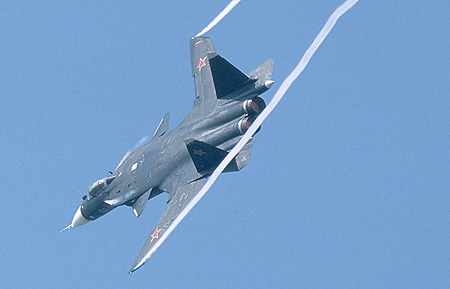Hugo Mambour/AviaScribe was stirred, if not shaken, at MAKS 2001.
Part one: Tomorrow never dies...
Since the end of communism in Europe, to criticise Russia in a negative way for what it has become is a popular activity for short-minded people. This feeling seems to have replaced the sustained paranoia of the cold war era when the Soviet Union was considered as THE potential aggressor. However, people travelling to Russia often come back with a different feeling and as a result are more suspicious about the mass media!
So it is for the Russian aerospace industry, which, despite dramatically reduced order books and huge financial problems, continues to survive and to create new flying machines. A key element to understand is that situation and others - what is true for Russia is not for the rest of the world, and conversely it is probable that a European aerospace industry in the same situation would have collapsed a long time ago.
 The
biannual Moscow International Aerospace Salon (MAKS, Mezhdunarodnyi Aerokosmicheskiy
Salon) is always a unique opportunity to check the vitality of the Russian
aerospace industry and MAKS 2001, held at the Gromov Flight Research Institute
(LII) airfield at Zhukovskiy in August, was no exception. Opened by the
President of the Russian Federation Vladimir Putin himself, MAKS 2001
was full of riches - besides very light aircraft, some completely new
aircraft types were seen publicly for the first time, although all were
civilian. They included the Su-38L agricultural aircraft, which made its
maiden flight only a few weeks before the airshow on 27 July and the Su-80
that flew for the first time after the show on 5 September. The latter,
previously known as the S-80, could possibly be built as a military transport
variant in the future.
The
biannual Moscow International Aerospace Salon (MAKS, Mezhdunarodnyi Aerokosmicheskiy
Salon) is always a unique opportunity to check the vitality of the Russian
aerospace industry and MAKS 2001, held at the Gromov Flight Research Institute
(LII) airfield at Zhukovskiy in August, was no exception. Opened by the
President of the Russian Federation Vladimir Putin himself, MAKS 2001
was full of riches - besides very light aircraft, some completely new
aircraft types were seen publicly for the first time, although all were
civilian. They included the Su-38L agricultural aircraft, which made its
maiden flight only a few weeks before the airshow on 27 July and the Su-80
that flew for the first time after the show on 5 September. The latter,
previously known as the S-80, could possibly be built as a military transport
variant in the future.
Super Sukhois
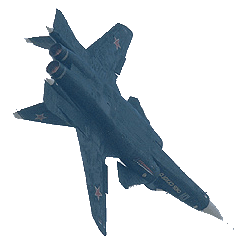 A
third Sukhoi design could have been interpreted as a new aircraft, but
it was just a change of designation. The S-37 Berkut multi-role fighter
demonstrator has indeed become the Su-47 in order to avoid confusion with
A
third Sukhoi design could have been interpreted as a new aircraft, but
it was just a change of designation. The S-37 Berkut multi-role fighter
demonstrator has indeed become the Su-47 in order to avoid confusion with
 the
former thrust-vectoring Su-37. Although the Berkut did not appear on static
display, just as two years ago, its flying display performance was noticeably
improved, indicating the progression of the test program. Other Sukhoi
products included one of the very few series Su-27M/Su-35,
seen for the first time on public display (other Su-35s shown previously
were prototypes) and the new twin-seater Su-35UB,
which was another surprise. This new sub-version was seen for the first
time and is aimed at the export market - Sukhoi is indeed a competitor
in the F-X program of the RoKAF, which intends to replace its F-5 fleet
and its older F-4s with a twin-engine fighter. Another candidate for the
F-X competition is the Su-37, which is now flying
without mobile nozzles. According to
the
former thrust-vectoring Su-37. Although the Berkut did not appear on static
display, just as two years ago, its flying display performance was noticeably
improved, indicating the progression of the test program. Other Sukhoi
products included one of the very few series Su-27M/Su-35,
seen for the first time on public display (other Su-35s shown previously
were prototypes) and the new twin-seater Su-35UB,
which was another surprise. This new sub-version was seen for the first
time and is aimed at the export market - Sukhoi is indeed a competitor
in the F-X program of the RoKAF, which intends to replace its F-5 fleet
and its older F-4s with a twin-engine fighter. Another candidate for the
F-X competition is the Su-37, which is now flying
without mobile nozzles. According to  Sukhoi,
super manoeuvrability can also be reached without such system thanks the
improved flight control system now being tested on this aircraft. But
of course, there is nothing like a thrust-vectoring Su-30MKI
to entertain the crowds! The complete range of Sukhoi's naval aircraft,
which constitutes the fixed wing air wing of the Admiral Kuznetsov, including
the Su-25UTG, the Su-33
and the still unique Su-27KUB (now in camouflage
scheme) flew a daily formation flypast routine
with every retractable gear hanging down and up! One Su-27IB/Su-34
was present as well.
Sukhoi,
super manoeuvrability can also be reached without such system thanks the
improved flight control system now being tested on this aircraft. But
of course, there is nothing like a thrust-vectoring Su-30MKI
to entertain the crowds! The complete range of Sukhoi's naval aircraft,
which constitutes the fixed wing air wing of the Admiral Kuznetsov, including
the Su-25UTG, the Su-33
and the still unique Su-27KUB (now in camouflage
scheme) flew a daily formation flypast routine
with every retractable gear hanging down and up! One Su-27IB/Su-34
was present as well.
The dedicated
ground-attack variant of the Su-27 currently suffers with some avionics
development problems and this led to the appearance at Zhukovskiy of a
most unexpected participant, a Tu-134Sh - which
is originally a navigator trainer variant - operated by the MIR Scientific
Production Enterprise based at Pushkin near St Petersburg. The Leninets
radar design bureau has indeed modified the Crusty as an avionics test
bed (designated L17-10V) for the Su-27IB program, the most notable modification
being the addition of a Su-27IB nose with its B004 radar. Official state
tests of the Su-27IB are scheduled for 2004-2005. A prototype of the Su-25TM/Su-39
that may not be produced as a serial aircraft was exhibited together
with an upgraded Su-25SM, which utilises some
of the equipment 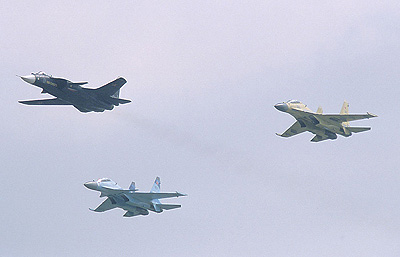 developed
for the Su-25TM (see Modernised VVS). The complete range of Sukhoi aircraft
could be admired both on the ground and in the air at Zhukovskiy. Each
day, Sukhoi types took a predominant part in the flying display. Besides
solo demonstrations of Su-30MKI, Su-30MK (actually
the Su-30MKI displayed at MAKS 99 - Sukhoi makes no distinction between
MK and MKI
developed
for the Su-25TM (see Modernised VVS). The complete range of Sukhoi aircraft
could be admired both on the ground and in the air at Zhukovskiy. Each
day, Sukhoi types took a predominant part in the flying display. Besides
solo demonstrations of Su-30MKI, Su-30MK (actually
the Su-30MKI displayed at MAKS 99 - Sukhoi makes no distinction between
MK and MKI  models,
both being identified as MK) or Su-47 among others, a massive take off
and flypast of the Sukhoi products was organised each day with Su-38L,
Su-29, Su-31, Su-25UB, Su-24MR, Su-27IB, Su-25UTG, Su-33, Su-27KUB, Su-30MKK,
Su-35UB and Su-47!
models,
both being identified as MK) or Su-47 among others, a massive take off
and flypast of the Sukhoi products was organised each day with Su-38L,
Su-29, Su-31, Su-25UB, Su-24MR, Su-27IB, Su-25UTG, Su-33, Su-27KUB, Su-30MKK,
Su-35UB and Su-47!
Mighty MiGs
RSK MiG,
the direct competitor of AVPK Sukhoi, had organised some form of resistance
but they all but collapsed at the end! MiG had last shown a varied flypast
of their products during MAKS 95. They repeated it in 2001, but unfortunately,
not every day like Sukhoi and not even for the closure airshow. As six
years before, its composite 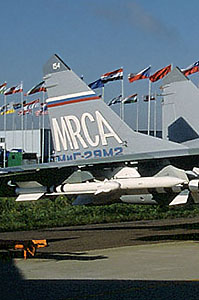 formation
composed of MiG-21UM, MiG-23UB, MiG-25PU, MiG-31 and MiG-29UB.
As always, the daily flying display was opened by a MiG-25PU
flypast. In all MiG had less aircraft types on display than before and
the absence of the MiG 1-42 demonstrator was keenly felt.
formation
composed of MiG-21UM, MiG-23UB, MiG-25PU, MiG-31 and MiG-29UB.
As always, the daily flying display was opened by a MiG-25PU
flypast. In all MiG had less aircraft types on display than before and
the absence of the MiG 1-42 demonstrator was keenly felt.
 Curiously,
no upgraded MiG-29SMT/UBT was present this year although the modernisation
program of some of the VVS Fulcrums should start soon. The usual MiG-21-93
prototype did fly however, as well as a MiG-31E,
which is an export variant that has been promoted without success for
several years. The future Indian Navy order of around 50 MiG-29Ks
will be most welcome by MiG and the aircraft designer has optimistically
launched three new sub-variants of its best seller MiG-29, which are in
fact based on the MiG-29M and K model. The MiG-29M2, advertised as the
MRCA (already seen before?!) is a two-seat multi-role combat aircraft
with a redesigned nose section and is equipped with a refuelling probe
and a Phazotron Zhuk-M radar. In addition, the fighter has now a digital
fly-by-wire control system. It made its first flight at Zhukovskiy on
26 September and is actively promoted to foreign customers, including
Malaysia. This new aircraft is actually very similar to the future naval
training-combat variant MiG-29KUB.
Curiously,
no upgraded MiG-29SMT/UBT was present this year although the modernisation
program of some of the VVS Fulcrums should start soon. The usual MiG-21-93
prototype did fly however, as well as a MiG-31E,
which is an export variant that has been promoted without success for
several years. The future Indian Navy order of around 50 MiG-29Ks
will be most welcome by MiG and the aircraft designer has optimistically
launched three new sub-variants of its best seller MiG-29, which are in
fact based on the MiG-29M and K model. The MiG-29M2, advertised as the
MRCA (already seen before?!) is a two-seat multi-role combat aircraft
with a redesigned nose section and is equipped with a refuelling probe
and a Phazotron Zhuk-M radar. In addition, the fighter has now a digital
fly-by-wire control system. It made its first flight at Zhukovskiy on
26 September and is actively promoted to foreign customers, including
Malaysia. This new aircraft is actually very similar to the future naval
training-combat variant MiG-29KUB.
 Another
fly-by-wire MiG-29 was standing next to the MRCA on static display. A
MiG-29M prototype had indeed been modified into the MiG-29OVT demonstrator,
which is equipped with Klimov-made 3D thrust-vectoring nozzles, mounted
on modified RD-33 engines. These nozzles, which were not operational on
the aircraft displayed during MAKS, can operate at any flight regime,
including full afterburner. Such engines will be available for the MiG-29M2,
as well as the MiG-29M1, which is basically a land-based version of the
MiG-29K. Both M1 and M2 models will retain their wing-folding mechanisms.
As these words are read, the 'real' MiG-29OVT flying prototype should
have been flown; also, the choice between the MiG-AT
and the Yak-130 should have been made by the
VVS. If the MiG-AT is chosen, it will be equipped with Russian Soyuz/Moscow
RD-1700 turbofans instead of the French Larzac 04-R20 engines, which should
equip export models only. The winner will replace the remaining Aero
L-39C Albatros training aircraft and will be used as a light ground
attack and air defence platform.
Another
fly-by-wire MiG-29 was standing next to the MRCA on static display. A
MiG-29M prototype had indeed been modified into the MiG-29OVT demonstrator,
which is equipped with Klimov-made 3D thrust-vectoring nozzles, mounted
on modified RD-33 engines. These nozzles, which were not operational on
the aircraft displayed during MAKS, can operate at any flight regime,
including full afterburner. Such engines will be available for the MiG-29M2,
as well as the MiG-29M1, which is basically a land-based version of the
MiG-29K. Both M1 and M2 models will retain their wing-folding mechanisms.
As these words are read, the 'real' MiG-29OVT flying prototype should
have been flown; also, the choice between the MiG-AT
and the Yak-130 should have been made by the
VVS. If the MiG-AT is chosen, it will be equipped with Russian Soyuz/Moscow
RD-1700 turbofans instead of the French Larzac 04-R20 engines, which should
equip export models only. The winner will replace the remaining Aero
L-39C Albatros training aircraft and will be used as a light ground
attack and air defence platform.
Besides the Vjazma based Albatros of the Rus team, one anonymous L-39C could be find in the vast static display area, which is actually on the second runway of the base. This unexpected Albatros, adorned with the Myasishchev design bureau badge on the nose, was equipped with an underbelly mounted GOES-520 gyro-stabilised optronic turret and missile launchers, which, in the absence of further information, were looking similar to 9M114 "Shturm" ATGM! This aircraft is probably intended for exportation. Some Army Aviation Mi-8MTV-2 and Mi-24V helicopters have been equipped with GOES-321 turrets and renamed respectively as Mi-8MTKO and Mi-24VK-1; such models were reportedly tested in Chechnya.
|
Airshow
acts
|
 |
 |
 |
Super Mirage!
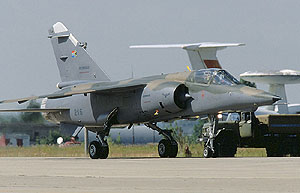 Among
the rare western aircraft on display at Zhukovskiy, the Mirage F.1AZ in
SAAF markings was definitely the most exotic one. This fighter, powered
by a Russian SMR-95 engine (modernised MiG-29 RD-33 engine) is able to
carry four R-73E AA-11 'Archer' air-to-air missiles. Named the Super Mirage
F.1, it has been developed in co-operation by Klimov and Vympel in Russia
and by Aerosud and Marvotech in South Africa. During the early nineties,
the SAAF had considered the upgrade of its Mirage F.1 with the help of
Russia, but the co-operation agreement broke down just after the first
materials had been shipped. However, a single airframe (n°216) had
been modified, early in 1994. As the Russian jet engine had been shipped
back to Russia, Mirage n°216 went to Zhukovskiy by Il-76. The Super
Mirage, again mated with a Russian engine, made its first test flight
from Zhukovskiy on 9 August 2001, piloted by Major Johannes Joubert of
the SAAF. It was claimed that it was the first flight of a foreign military
aircraft to take place from this airfield. It remains to be proved, as
for example, F-5s and A-37s were secretly tested in Akhtubinsk years before.
Although the last SAAF F.1 were officially retired on 25 November 1997,
negotiations between South African and Russian businessmen resumed in
2000, the objective now being to demonstrate the ability of the Russian
aeronautical industry to upgrade western aircraft. Numerous countries
are still flying the Mirage F.1, including 'rogue' ones, which cannot
get any help from Dassault. South Africa has still 21 Mirage F.1AZs in
storage at Waterkloof, waiting for a potential buyer. Armscor and Rosoboronexport
are now responsible for the marketing of the Super Mirage, the price for
the upgrade of a Mirage lying between three and four millions Dollars.
This F.1 upgrade concept is however anachronistic: the upgrade of older
aircraft most of the time concerns the avionics and the weapons systems
rather than the engine. Compared to the SNECMA Atar 9K50
Among
the rare western aircraft on display at Zhukovskiy, the Mirage F.1AZ in
SAAF markings was definitely the most exotic one. This fighter, powered
by a Russian SMR-95 engine (modernised MiG-29 RD-33 engine) is able to
carry four R-73E AA-11 'Archer' air-to-air missiles. Named the Super Mirage
F.1, it has been developed in co-operation by Klimov and Vympel in Russia
and by Aerosud and Marvotech in South Africa. During the early nineties,
the SAAF had considered the upgrade of its Mirage F.1 with the help of
Russia, but the co-operation agreement broke down just after the first
materials had been shipped. However, a single airframe (n°216) had
been modified, early in 1994. As the Russian jet engine had been shipped
back to Russia, Mirage n°216 went to Zhukovskiy by Il-76. The Super
Mirage, again mated with a Russian engine, made its first test flight
from Zhukovskiy on 9 August 2001, piloted by Major Johannes Joubert of
the SAAF. It was claimed that it was the first flight of a foreign military
aircraft to take place from this airfield. It remains to be proved, as
for example, F-5s and A-37s were secretly tested in Akhtubinsk years before.
Although the last SAAF F.1 were officially retired on 25 November 1997,
negotiations between South African and Russian businessmen resumed in
2000, the objective now being to demonstrate the ability of the Russian
aeronautical industry to upgrade western aircraft. Numerous countries
are still flying the Mirage F.1, including 'rogue' ones, which cannot
get any help from Dassault. South Africa has still 21 Mirage F.1AZs in
storage at Waterkloof, waiting for a potential buyer. Armscor and Rosoboronexport
are now responsible for the marketing of the Super Mirage, the price for
the upgrade of a Mirage lying between three and four millions Dollars.
This F.1 upgrade concept is however anachronistic: the upgrade of older
aircraft most of the time concerns the avionics and the weapons systems
rather than the engine. Compared to the SNECMA Atar 9K50  original
engine (7,200 kn with AB), the SMR-95 engine is 300 kg lighter and more
powerful (8,300 kn with AB). With 17,000 metres, the ceiling is 2,000
metres higher, whereas the range at cruising speed is augmented from 1,820
to 2,250 km. The maximum speed is voluntarily limited to Mach 1.8 (Mach
2.2 with the Atar engine). In any respect the flying display of that Super
Mirage was quite more aggressive than that of an ordinary F.1.
original
engine (7,200 kn with AB), the SMR-95 engine is 300 kg lighter and more
powerful (8,300 kn with AB). With 17,000 metres, the ceiling is 2,000
metres higher, whereas the range at cruising speed is augmented from 1,820
to 2,250 km. The maximum speed is voluntarily limited to Mach 1.8 (Mach
2.2 with the Atar engine). In any respect the flying display of that Super
Mirage was quite more aggressive than that of an ordinary F.1.
|
VVS heavies
|
 |
 |
 |
 |
 |
Modernised Fencers
As the Russian Combat Air Force (VVS) is currently unable to purchase a significant quantity of new combat aircraft, several modernisation programs of existing equipment have been initiated during recent months. Although the Su-24 is one of the oldest attack aircraft in the air force inventory at 26 years, the 'Fencer' is still at the spearhead of the Russian air forces with around 450 aircraft in service with both the VVS and the AVMF. Besides reconnaissance Su-24MRs and electronic warfare Su-24MPs, the main attack version of the Frontal Aviation is the Su-24M 'Fencer-D' (exported as the Su-24MK). Zhukovskiy-based Gefest & T and the Novosibirsk Aviation Production Association (NAPO) (named after Valery Chkalov) have been awarded the modernisation contract for the Su-24M and MK versions. The new avionics, replacing older equipment, will rely on the new SV-24 computer that will control the new radar signal processing unit Obzor-RVB-T associated to the OR-TM cartography, radar and tactical situation MFD, the new KAI-24 HUD and the SRNS-24 radio navigation equipment, among others. Thanks to technological progress, the replacement of older electronics means a saving of 270 kg. The technical personnel of the VVS are able to modify the aircraft on base, no particular conversion training is necessary, and the upgrade of the Su-24M to the Su-24M2 can be done in five days. Thanks to its new equipment, the Su-24 has gained a real all-weather night and day capability. The precision of the navigation has been improved and the export models - some of them are on line with the VVS - can be equipped with either a GPS or its Russian GLOSNASS equivalent. The range of weapons has been diversified and the export versions can carry foreign armaments. The new Obzor signal-processing unit allows a greater precision for target acquisition and at a greater distance. Toss bombing is now possible at five to eight kilometres from the target with an increased accuracy. Survivability of the aircraft is consequently better and less aircraft are necessary to destroy the target. The upgrade program includes a ground-based automated mission preparation and control unit, which reduces appreciably the time necessary for flight preparation and debriefing. The 929.GLITs at Akhtubinsk and the 968.IISAP at Lipetsk are responsible for the test and certification program. SV-24 tests, which included live weapons shooting, were successfully passed at Lipetsk. Around the end of 2001, five Russian Su-24Ms and seven Algerian Su-24MKs had been upgraded.
Frogfoots too
|
It
wasn't all modern
|
 |
 |
 |
 |
 |
 |
Moreover, around 100 Su-25 and Su-25BM 'Frogfoot-A's, as well as some Su-25UB 'Frogfoot-B's, all with an average age of more than ten years old, will be upgraded by the aircraft repair plant (ARZ) n°121 at Kubinka, with the support of the 'Shturmoviki Sukhogo' consortium until 2008. The first Su-25SM (serial, modernised) was on static display during MAKS. The first test flight of this aircraft took place in February 2002 and the certification program is scheduled to last until the September. Two additional aircraft are being overhauled and upgraded at Kubinka and they should be ready for tests respectively in April and July 2002. As for the Su-24M, the modernisation program will concentrate only on avionics and will give the aircraft a true day and night capability. The impact precision of the weapons will be multiplied by a factor of two to three and the accuracy of navigation by a factor of ten. The main new equipment will included the Pantera nav/attack system with the internal radar RLPK-25SM, the Pastel RWR and the Omul ECM pod. All that equipment is derived from that developed for the Su-25TM. The weapons arsenal of the Su-25SM will be extended with R-27 AA-10 'Alamo', R-73 AA-11 'Archer' and R-77 AA-12 'Adder' air-to-air missiles, as well as the Kh-29T AS-14 'Kedge' TV-guided air-to-ground missile and the optically-guided KAB-500Kr bomb. Furthermore, the radar cross section of the aircraft should be reduced with RAM material and special paint. The Su-25SM will be commercialised, becoming thus a direct competitor of the Israeli-Georgian Su-25KM Scorpion shown at Le Bourget last year.
The VVS has also decided to reinforce its ground-attack assets with Su-30 aircraft. Up to know, only five Su-30s were operational with the air defence 54.GvIAP at Savasleika. Other Su-30 models exhibited during various public shows in Russia and abroad were just prototypes, development aircraft, or export versions like the Chinese Su-30MKK. In the next three years, around 30 Su-27UBs - and probably the air defence Su-30 - will be upgraded into multi-role combat and reconnaissance aircraft by the addition of appropriate avionics. New equipment will include an in-flight refuelling probe (when applicable), GlOSNASS, new mission computer, whereas the N-001 radar will be equipped with a new electronic antenna, better adapted to the new missions of the aircraft. In order to reduce the radar signature, new meshes should be added in front of the engines and RAM material will be used as well. According to the present schedule, eight aircraft will be upgraded this year, twelve in 2003 and ten in 2004. The upgrade program will be undertaken by IAPO in Irkutsk, with the collaboration of the AVPK Sukhoi, although it remains to be seen what will be the final designation of the upgraded aircraft. The first upgraded Su-27UB (bort 20) was taken on charge by the Akhtubinsk test centre on 6 March 2001 as the Su-27UBM. Moreover, it had been announced last year that the Su-30K would be upgraded to Su-30KN standards. Nevertheless, besides the Savasleika Su-30, no other Su-30 version is operational with the VVS. A single Su-30KN exists at the present time. That aircraft (bort 302) was officially certified on 9 November 2001. The designer has also claimed that the single-seater could be upgraded as Su-30KN.
 Other
aspects of MAKS
Other
aspects of MAKS
Other participants in the flying display included the traditional Swift team and their MiG-29s (two MiG-29 model 9-13 'Fulcrum-C's have joined the 'Fulcrum-A and B' of the team - they wear a red spine instead of a blue one) and the Russian Knights with their Su-27s. A new civilian team, composed of former military L-29 had the honour to close the last day show. The 'Knights of the Sky', as they are called, are based at nearby Myachikovo, where many a colourful L-29 can be found, among other types. A recently rebuilt Po-2, also from Myachikovo, flew daily. The most interesting historic aircraft present at Zhukovskiy was however a Polikarpov I-15bis or I-152. Now flying with an An-2 engine and propeller, this original aircraft was recovered in Karelia in 1997. Rebuilt at Novosibirsk, it made its maiden flight on 11 July few weeks before the show and has since been bought by an American collector. Other vintage or historic aircraft on show included a Yak-12, a Shavrov Sh-2 replica and a Il-14M, which used to be the personal aircraft of Marshal and ace Pokryshkin when he was Chairman of the Central Committee of DOSAAF paramilitary organisation.
So, once again, MAKS lived up to expectation, presenting a thorough image of the CIS aerospace industry, ranging from well-known designers to small workshops (of which more next time!).
Part two: For your eyes only...
